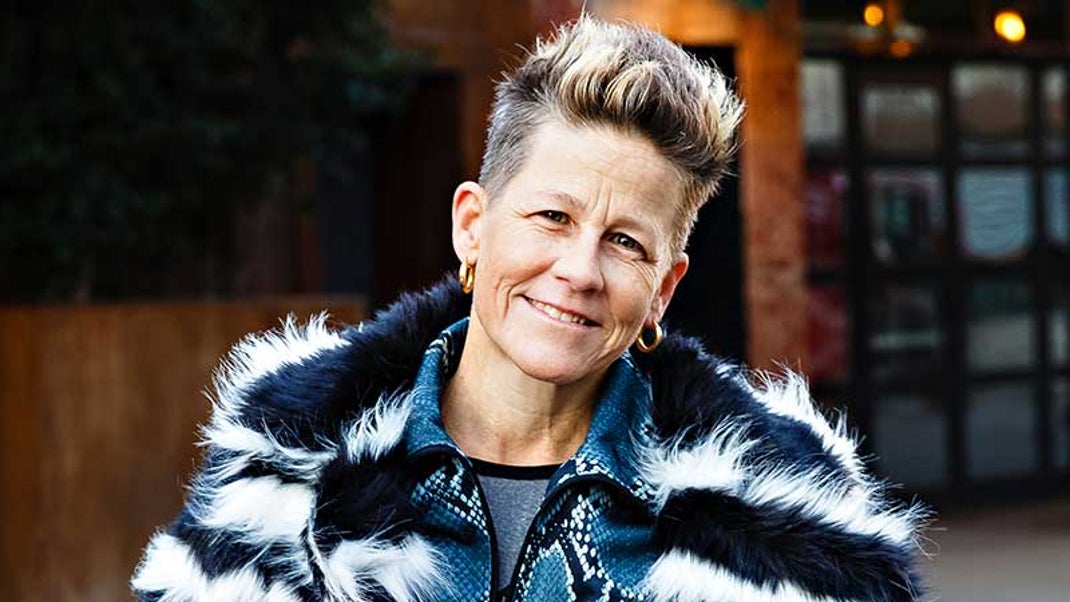Good Karma Awards is pleased to announce the Top 10 Yoga Service Organizations of 2018! This list recognizes those who have made significant contributions in the field of yoga service. We hope that you will find it as inspiring as we did when we put it together.
This year we launched a social campaign and asked for your help in nominating organizations with a track record of successfully integrating yoga into local communities as a tool for health and happiness. Thanks to all of you who answered the call! It was inspiring to learn more about the expanding role of yoga service. To determine our 10 finalists, we relied on the expertise of partners from the Yoga Service Council, Give Back Yoga Foundation, Yoga Alliance, and Lululemon’s social impact program Here to Be. Together they chose 10 exemplary organizations that are making bold strides in their communities.
Thanks to a generous grant from Lululemon and Here to Be, all 2018 Good Karma Award winners will be heading to the annual Yoga Service Conference at Omega Institute next May, and $10,000 will go to ACT Yoga, an organization founded by a former inmate who began practicing and teaching yoga while incarcerated. He now works tirelessly to bring the benefits of yoga to underserved communities throughout Chicago.
Grant Winner: ACT Yoga
 CHRISTOPHER DOUGHERTY
CHRISTOPHER DOUGHERTY
Founder: Marshawn Feltus
ACT Yoga will be awarded a $10,000 grant from Lululemon and its social impact program, Here to Be, to help deepen its effect and reach.
At age 17, Marshawn Feltus thought his life was over. A native of Austin, one of the most violent neighborhoods on Chicago’s West Side, he got into a street altercation and shot and killed another young man. “I was a knucklehead kid defending territory and expressing my anger in a bravado way,” he says. “It was senseless violence.” Feltus was sentenced to 38 years in state prison. While he was incarcerated at Illinois River Correctional Center, another inmate persuaded him to try yoga. He reluctantly rolled out a bath towel (they didn’t have yoga mats) in an old chapel space, and within five minutes of his first yoga practice, he knew he had found an important tool. “I felt the tension release in my muscles and my mental stress dissolving. It was instant for me.” Over time, he felt calmer, was sleeping better, and felt less agitated. A few months later, the instructor of the class stepped down and called on Feltus to replace him. Feltus led classes for two years—eventually reaching up to seven classes a week and instructing more than 800 fellow inmates. His program became the only organized activity at Illinois River without a single violent incident on its record. “My experience with yoga eventually took me past the physical asana into a conscious way of thinking about all aspects of my personal life and society,” he says. “I had a clearer perspective to examine the lessons I’d learned and my thoughts and goals.”
After serving 18 years and 9 months, Feltus was released (a result of Illinois’s former day-for-day structure, in which half the original sentence was served in prison with other time on parole). He returned to Austin with a new purpose: to bring the healing power of yoga to his community. He completed a local entrepreneurship program and a 200-hour teacher training at Chicago Yoga Center and opened Austin’s first yoga studio, within the Bethel New Life Community Center.
He calls his studio ACT Yoga—which stands for Awareness, Change, Triumph (an acronym he used in prison to encourage other inmates to enroll in the GED, college, and self-help programs). Now, by teaching yoga in jails, schools, community centers, and other institutions around Chicago, in addition to his studio, he spreads the practice that gave him a second chance at life.
Q & A
Yoga Journal: Can you describe ACT’s mission and how it helps your community?
Marshawn Feltus: The first component is to educate people on what yoga is and what it can do for them. It amazes me how so few people actually take the time to close their eyes and take a deep breath. The second component is to make yoga accessible. Our classes range from $8–$12. We don’t want our prices to mean people have to take things off their grocery lists.
YJ: How do you embody the yogic concept of Seva, or “selfless service”?
MF: Yoga is multidimensional, and you have to look at what different people need. If you try to say, “We’ll do it our way and make everybody conform,” it doesn’t work. If you can tap into what individuals need, you have better buy-in. When I meet someone who’s never been on a yoga mat or seen the inside of a yoga studio, I try to get to know them, and then say something like, “You know, if your back is hurting, I know a few things for that.” They may never come in for a traditional class, but at least I’ve planted the seed.
YJ: What are your goals for the future, and how do you plan to use the $10,000?
MF: This is a really key time for us to receive this award. The main plan is to train more yoga teachers from the community and to help more people. We’ll also be able to buy some props and pulley carts, which we need to transport our mats when we’re out doing pop-up yoga sessions on the street; we’ll fix our website, which is down because of malware; and we’ll be able to do wellness checks where we sit down and buy a meal for someone and have a conversation—that goes a long way.
Organization: Three and a Half Acres Yoga
 Robert Sturman
Robert Sturman
Founder: Lara Land
“Each human needs about three-and-a-half acres of land to breathe properly,” says Sharath Jois, director of the Ashtanga Yoga Institute in Mysore, India. It’s a message with a deep application to everyday life: When we feel confined, trapped, or disempowered, we lose connection to a fundamental part of our humanity. Three and a Half Acres Yoga, a nonprofit in Harlem, New York, says its mission is creating space: space for healing, space for connection, space for peace and wellbeing. By partnering with local organizations—including schools, recovery centers, and food banks—Three and a Half Acres Yoga brings trauma-informed yoga to spaces where it might not otherwise exist.
Q & A
Yoga Journal: How did you find your way to this work?
Lara Land: I was first introduced to yoga service many years ago, in Kigali, Rwanda.
I was there for three months doing yoga with genocide survivors. It was a life-changing experience to witness how powerful the practice was. I met people who had been through multiple rapes, who had machete scars, who had been through a war. When I saw that yoga could be used to help people heal from trauma, I thought, “I have to bring this home to my community.”
YJ: How does Seva influence your organization’s mission?
LL: For me, it comes down to empowerment. Ultimately, we’re helping students—especially those who have been through trauma—to recognize their own power. Giving a person space to explore and feel safe is an amazing thing. Both the facilitator and the student receive and exchange. It’s selfless service when everyone is learning.
YJ: What does the future look like for Three and a Half Acres Yoga?
LL: Right now we’re moving into the next phase of our organization, which is more cross-pollination between marginalized populations and bringing different people together to integrate with their communities. We’re looking at how yoga, mindfulness, and breathwork can heal and bridge gaps in a community.
Organization: Yoga 4 Change
 TIFFANY MANNING PHOTOGRAPHY
TIFFANY MANNING PHOTOGRAPHY
Founder: Kathryn Thomas
Kathryn Thomas, a former naval aviator, was told she’d never fly helicopters again after a 2012 accident during a deployment aboard the USS Monterey left her with nerve damage and no feeling in one of her feet. To help her recover, her physical therapist recommended yoga. Thomas says stepping onto the yoga mat made her feel like she was enough—for the first time since her accident. In 2014, Thomas founded Yoga 4 Change (Y4C), a Florida-based organization that helps others heal from trauma by serving four specific populations: youth, military veterans, incarcerated individuals, and those in recovery. More than 80 Y4C facilities offering 6-week, 10-week, and opioid-specific programs exist throughout the state.
Q & A
Yoga Journal: What makes Y4C unique?
Kathryn Thomas: Through our programs, we collect both quantitative and qualitative data used for research at Boston University. This includes measuring self-compassion, anxiety, post-traumatic growth, sleep, wellness, and mental health before and after our programming. The impact shown through the data has led to our programs being used in court sentencing. Fourth Circuit judges are now sentencing individuals to Yoga 4 Change programming, like the way they sentence individuals to anger management or domestic violence prevention programs.
YJ: How did this partnership with Boston University get started?
KT: I met researcher Danielle Rousseau through work with the Yoga Service Council. We enjoyed working together and hoped to one day do a research evaluation of Yoga 4 Change. Once we formed a partnership, we were able to secure funding for the study.
YJ: What does healing look like at Y4C?
KT: There was a woman who came into one of our classes with scars from her wrists to her elbows. She breathed with us and did one Upward-Facing Dog, and she stood up and said, “Oh, my God. I feel my hips. I’ve never felt my hips.” I came to learn she was involved in human trafficking. She had so much trauma in her life, and she’d blocked off sensation as a coping technique. Through yoga, she was able to feel her body in a new and positive way—that’s why we do this.
Organization: DeafYoga Foundation
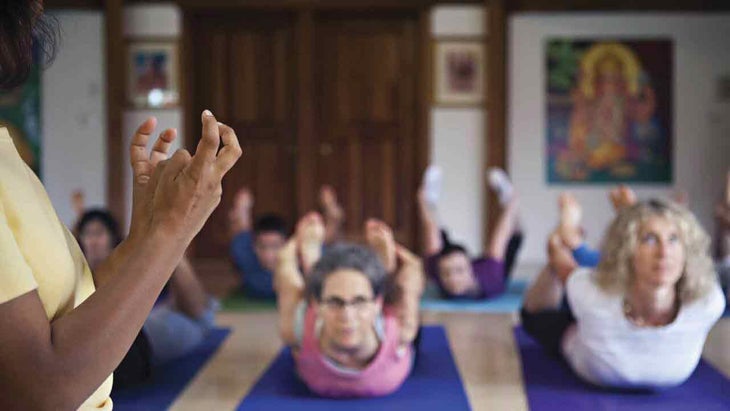 CHARLIE PAPPAS PHOTOGRAPHY
CHARLIE PAPPAS PHOTOGRAPHY
Founder: Lila Lolling
There are 34 million people in the United States who are either deaf or hard of hearing, yet access to yoga classes led by deaf and signing teachers in American Sign Language is still a relatively scarce resource—a fact that the nonprofit DeafYoga Foundation (DYF) is working to change. In the past decade, DeafYoga has certified nearly 50 deaf yoga teachers and trained more than 150 language professionals in yoga-specific ASL interpretation nationwide. Jessica Frank, codirector of DeafYoga Foundation (and a deaf yoga teacher herself), gave us her insights into this organization that’s striving to make the richness of yoga accessible to the deaf and signing community.
Q & A
Yoga Journal: How did you get involved with DYF?
Jessica Frank: I took a yoga teacher training in 2011 that was made accessible through DYF sign language interpreters. I became acquainted with DYF’s founder, Lila Lolling, at the training. Very quickly we saw that we had shared goals and a similar vision for her foundation. She asked me to join her, and the rest is history!
YJ: What do you plan to do next with yoga teaching and your work with DYF?
JF: I underwent trauma-informed yoga training in 2017, and I’m hoping to start sharing this particular approach with the deaf community. As for DYF, we’re aiming to create an affordable online video resource center to offer deaf people the option of deepening their yoga practice from the convenience of their homes.
YJ: What does Seva mean to you, in your life and practice?
JF: Seva emphasizes the importance of community. It focuses on what unites us rather than what separates us. Selfless service is taking the necessary steps to heal our collective well-being. It’s also the humbling reminder that life serves a purpose so much larger than our individual selves.
Organization: Accessible Yoga
 DARSHAN NOHNER
DARSHAN NOHNER
Founder: Jivana Heyman
Everyone, regardless of physical ability or background, deserves access to the practice of yoga. That’s the guiding principle behind Accessible Yoga. Its mission is to advocate for underserved communities and build a network of ambassadors to support yoga accessibility around the world. The organization initially focused on accessibility for those with physical disabilities or chronic illnesses and has since grown to include advocacy for anyone who lacks access due to physical, emotional, cultural, or economic barriers. In 2015, the organization launched its first international conference and brought a message of inclusivity to a global audience.
Q & A
Yoga Journal: What inspired you to start advocating for accessibility in yoga?
Jivana Heyman: I was an AIDS activist in the late ’80s and early ’90s. Many of my friends died of AIDS, including my best friend. I started teaching yoga to the HIV/AIDS community, and then the work extended from there. I didn’t see yoga being shared with people with physical disabilities and chronic illnesses, so that’s where I put my focus. There’s a misunderstanding that yoga is about advanced physical asana when that is only part of the practice. Yoga is about learning to calm the mind and connect with inner peace, and that’s something that everyone has a right to.
YJ: How does Accessible Yoga approach its advocacy work?
JH: This year, we have two international conferences, and that’s really our main focus—creating a platform for people who are sharing yoga in marginalized communities. These people come together and network with each other and learn about each other’s work. This, we hope, will shift the culture to be more inclusive and equitable.
YJ: What does the concept of Seva mean to you?
JH: I think “selfless service” is yoga in practice. The real challenge is learning how to think beyond your ego’s selfish desires, to look at others as equals, and to come from a more heart-centered place that can bridge the divide between individuals and communities. That’s what we’re trying to do with Accessible Yoga.
Organization: Yogis of Color Crushing It
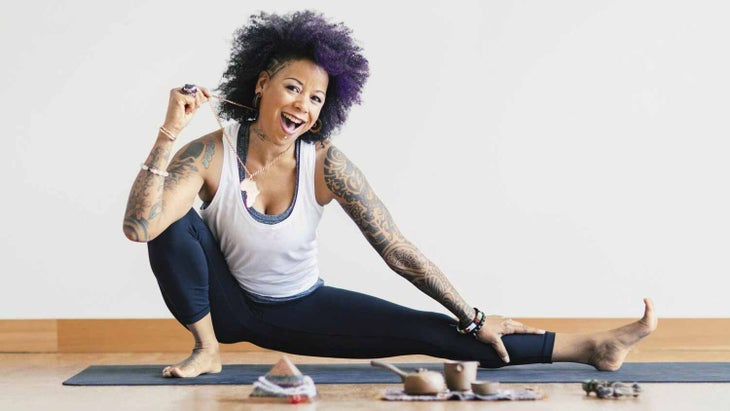 MATT GONZALEZ
MATT GONZALEZ
Founder: Bibi McGill
If anyone can speak with authority on the topic of crushing it, it’s Bibi McGill. She toured the world as the lead guitarist and music director for Beyoncé’s backing band, the Suga Mamas, from 2006 to 2014; performed with Pink on her 2001 promotional tour, and appeared on Saturday Night Live and the Tonight Show.
After leaving the world of high-profile touring, she transitioned to a quieter existence at home in Portland, Oregon, to focus on one of her other great passions: yoga. She founded Yogis of Color Crushing It, a series of donation-based pop-up classes, as a way of uniting and empowering people of color within the yoga community—an effort, she says, to inspire greater diversity within yoga and to show people of color that yoga belongs to them just as much as it belongs to anyone else.
Q & A
YOGA JOURNAL: When did you start thinking about racial diversity in yoga?
Bibi McGill: I guess it just came into my peripheral vision over time—this reality that I didn’t see a lot of melanated people doing yoga. (I don’t like to say “black” and “white.”) I asked some of my friends in Portland, “Why don’t melanated people do yoga?” My friend said, “Bibi, we do! We just don’t go to yoga studios because we don’t feel comfortable. I’ll bet if you taught some classes, people would come.” That was the start.
YJ: Can you describe the first event you did with Yogis of Color Crushing It?
BM: The first pop-up I did for people of color here in Portland was a smash. It was interesting to see the diversity. We had Filipino people who participated, Korean and Japanese people, people from East India and Iran and Persia, from South America and Africa. It was a great feeling to look out into the crowd and see everybody smiling, everybody feeling safe.
YJ: Do you plan to expand Yogis of Color Crushing It?
BM: Absolutely. There’s a need for this all over the world. I want people of color to experience the practice. I don’t want them to feel like they can’t go to a studio because the teacher doesn’t look like them and nobody in the class looks like them. I want them to have a place to come where they’re going to be loved and feel safe.
Organization: I Grow Chicago
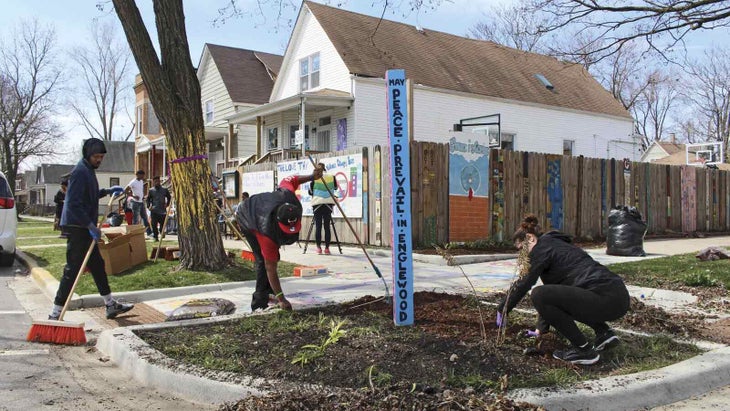 CONNOR SULLIVAN
CONNOR SULLIVAN
Founder: Robbin Carroll
I Grow Chicago began with a simple question: “Do you want to take back your community?” In 2014, Chicago businesswoman Robbin Carroll arrived in Englewood—a high-crime neighborhood—with a simple goal: Empower residents to bring peace and safety back into their lives. At the time, Englewood was in the news often for its violence, and Carroll wanted to know why a neighborhood in her own city was being treated like a war zone. With a mission statement focused on “creating a world where love lives in public,” the organization offers yoga, gardening, tutoring, mentorship, and more through its resident-run community center, the Peace Campus. Zelda Mayer, director of development, spoke with us about the organization’s efforts to promote healing through a simple yet powerful philosophy: “If in doubt, love.”
Q & A
Yoga Journal: What kind of work do I Grow Chicago focus on?
Zelda Mayer: It addresses trauma and the root sources of poverty, isolation, and racism. We run programs aimed at bringing hope and healing to all—everything from yoga classes and teacher training to job transportation and after-school tutoring. It’s whatever the community needs.
YJ: How did you get started?
ZM: The area around our current location, the corner of West 64th and South Honore Street, used to be incredibly violent. Our founder, Robbin, showed up one day with Subway sandwiches and started asking people if they wanted to help heal the neighborhood. The first person who approached her was our co-executive director, Quentin Mables, an Englewood native. He just took some garbage bags out of her hand and started cleaning up the block.
YJ: How do you engage the community in I Grow Chicago’s work and mission?
ZM: We hire community members—that’s part of our model. When we first started, the police commander at the time pulled Robbin aside and said, “You know, you’re letting cold-blooded killers into your community center.” Robbin said, “I hear you, but those cold-blooded killers are the ones planting flowers in our garden.”
Organization: Cultivate Union
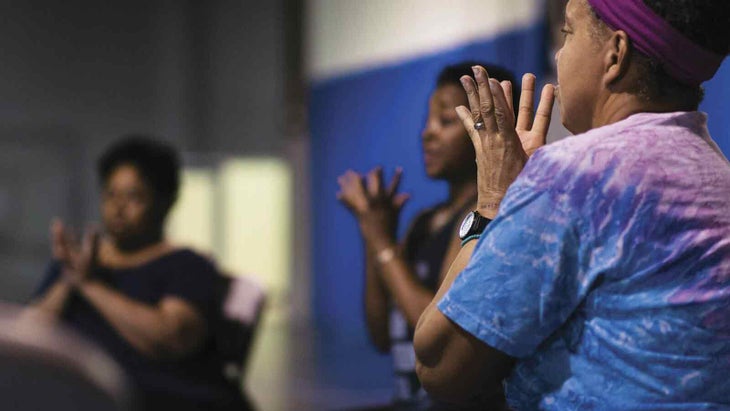 MARY CLAIRE STEWART
MARY CLAIRE STEWART
Founder: Rachelle Knowles
Teacher training and certification courses, though enriching and life-changing, can also be prohibitively expensive. The Atlanta-based nonprofit Cultivate Union provides financial assistance to local yoga teachers who want to deepen their practice through specialized courses. The hope is to create a larger, more diverse community of instructors who bring a variety of perspectives to their practice. With a broader range of socio-economic positions represented within the yoga community, the community itself becomes more inclusive and equitable.
Q & A
Yoga Journal: What has been an important lesson you’ve learned in running this organization?
Rachelle Knowles: If you want to make a change, you just have to get out there and start taking action. I didn’t wait until I had tens of thousands of dollars in financial assistance to get Cultivate Union off the ground. I started with a $2,500 grant and within two months, Cultivate Union was awarded its first $500 in financial assistance. It was almost like using motion to generate motion.
YJ: How has the organization grown and evolved since you started it?
RK: Initially, we focused on assisting only current instructors, but recently, we’ve moved toward putting aspiring teachers through their first teacher training, providing up to half of their tuition. We’re also looking into more strategic partnerships with the aim of making an impact in other cities.
YJ: Can you tell us about someone you’ve helped with financial assistance?
RK: This year we granted a student $1,800 to help him complete his 200-hour training. One thing we ask of large-grant recipients is that they create some sort of community-based project as a way of reciprocating the offerings. This young man is forming a workshop for queer people of color and anchoring it with spiritual practices from the African diaspora. That was just so moving for me.
Organization: CTZNWELL
 KERRI KELLY
KERRI KELLY
Founder: Kerri Kelly
Well-being is a human right, but our politics and institutions don’t always treat it as one. CTZNWELL is determined to change that. The nonprofit operates according to the idea that “change begins with people.” It uses a three-pronged approach to bring that change into reality: personal practice, community building, and collective action. Rich with resources for inspiring civic engagement—including a podcast on the politics of wellbeing, a weekly toolkit of curated reading, and numerous campaigns to promote social justice—CTZNWELL is a digitally fluent, community-based organization that integrates yoga and other grounding practices into all of its activist work. All CTZNWELL’s methods are rooted in presence and meditation to help make the world a healthier and more equitable place.
Q & A
Yoga Journal: What is CTZNWELL’s primary mission?
Kerri Kelly: CTZNWELL is working to democratize well-being. Currently, there’s a gap between who gets to be well and who doesn’t. That’s not by accident; it’s fully systemic. At CTZNWELL, we’re all about tackling the big systemic barriers, such as the legacies of racism, misogyny, and inequality in this country that need to be acknowledged and healed. It’s an everyday practice of civic engagement that should be synonymous with yoga practice: You wake up, meditate, call your representatives; you go to yoga class and then hit the streets; you buy organic and vote your values. It’s not enough to just show up when there’s a crisis or an election. We can engage every day in civic practice and help bring forth the conditions where everyone can be well.
YJ: How did you get involved in this work?
KK: My big political wake-up call was 9/11 when I lost my stepdad, a fireman. That moment dismantled everything I had learned about what it meant to be safe and well. And yoga was there to help me navigate the grief and chaos and get on a path of purpose. I started gravitating toward yoga service, community organizing, and eventually social and political change.
YJ: How does Seva inform CTZNWELL’s work?
KK: If we truly want to embody the practice of yoga, we have to learn how to take better care of ourselves and one another. With CTZNWELL, we saw an opportunity to practice beyond ourselves and serve the bigger whole.
Organization: Yoga For First Responders
 GORMON HOUSE PHOTOGRAPHY
GORMON HOUSE PHOTOGRAPHY
Founder: Olivia Kvitne
Olivia Kvitne, whose background involves yoga for veterans and active military personnel, founded Yoga for First Responders (YFFR) in 2013 to bring trauma-sensitive yoga and resiliency training to members of the Los Angeles Fire and Police Departments. From there, her efforts have expanded to include a wide range of classes and training for emergency personnel of all types.
Q & A
YOGA JOURNAL: Why did you decide to focus on first responders?
Olivia Kvitne: First responders see more trauma, loss, death, and destruction in one day—one shift—than you or I might see in our entire lives. The nervous system isn’t built for taking that much of a beating, and yoga is a beneficial tool for regulating it.
YJ: How do you customize your teaching for firefighters and police officers?
OK: The yoga we’re doing is traditional hatha yoga, but we’re branding it a little differently. What we call “tactical breathwork” is really pranayama, but we change the language. It’s nothing against Sanskrit; I love the Sanskrit language. But the question is: What’s going be more beneficial and get more people on board?
YJ: How did you prepare for working with this population?
OK: When I was developing this program, I did a police ride-along and went through police academy training. I attended a fire academy, too, which involved doing live burns and fighting the fire. I wanted to get as close as I could so I could feel what this population feels every day and understand what they need.
Conclusion:
Yoga Journal magazine presents the Top Ten Yoga Service Organizations of 2018. These organizations are making a positive difference in their communities by providing yoga classes, trauma-sensitive sessions for first responders, and more.



